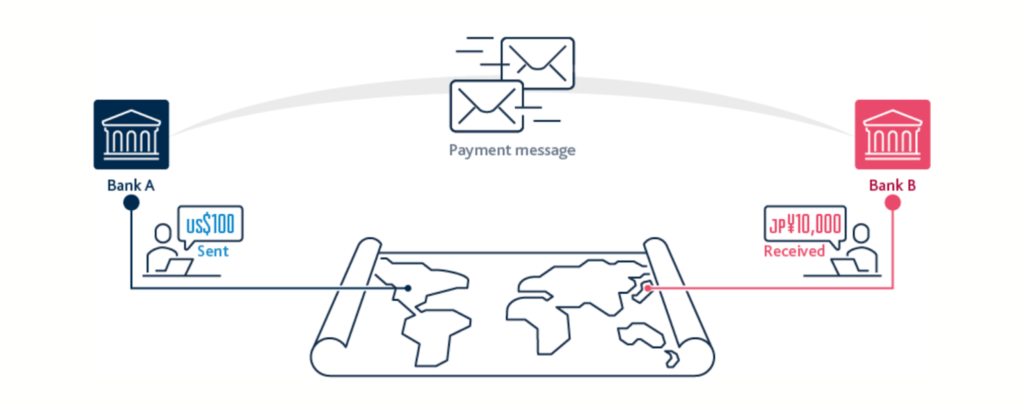Cross-Border Payments in 2024: Mechanism Explained



Globalization is massively driving demand for secure, faster, and efficient cross-border payment modes. Currently, cross-border transactions account for over $34 trillion in value. The market growth around this mode of payment has seen it gain massive traction and competition from neobanks, fintechs and money service businesses that aim to take advantage of the opportunities that they bring aboard.
Cross-border payments, also referred to as international payments, are transactions performed by a paying entity to a recipient that is in a different country. The payment literally crosses the border, thus the terminology. In an e-commerce setup, this type of payment is made by a customer from one country purchasing items or services located in a business in another country.

In ideal scenarios, it’s possible to perform cross-border payments within seconds, minutes, hours or even days depending on the number of intermediaries involved. Nonetheless, you can perform most of these transactions 24/7 all year round. By leveraging existing and new infrastructure such as smart contracts to facilitate real-time payments, fintechs and neobanks are addressing the challenges faced in traditional international payments. In this article, we will explore cross-border payments and how they work!
There are two types of NFTs. Read our guide to learn more about on the difference between static and dynamic NFTs.
How Does Cross-Border Payments Work?
While a normal transaction between two entities in the same country involves a system that transfers funds from the sender to the recipient, this type of payment is more complicated. This is because in a cross-border transaction, there is a change in currency involved. The currency exchange in such a transaction is determined by a fluctuating exchange rate which complicates the transaction further.
In a cross-border payment, there are also transaction fees to consider, which further complicates the transaction due to extra steps and banking systems involved in the payment. Basically, for an international payment to happen, the sending bank must have a counterpart or partner bank in the recipient’s country to facilitate this transaction.
However, a direct payment can be done from the sender’s bank to the recipient bank if the sender has an account on the recipient (partner) bank. But if the sender doesn’t have an account on the partner bank in the other country (which is the case in most scenarios), the payment is first deposited to the counterpart bank and then transferred to the recipient’s account.
In some incidents, there might be several banks involved in a cross-border transaction with all the banks navigating through exchange rates, legal regulations, and transaction fees to facilitate a particular transaction. This explains why cross-border payments are much slower than transactions within the same country. However, with the blockchain technology, these transactions can be faster, secure, and cheaper.
What are the Types of Cross-Border Payments?
There are several types of international payments. Let’s look at a few of them below:
Credit Card Payment
Credit card payments are consumer-favorites when it comes to cross-border payment methods. This is because with credit cards, the consumers only need to fill their data (card details) and authorize the payment which is performed automatically.
However, despite the ease in making a credit card payment, this form of payment has more going on behind the scenes. For instance, the funds must be converted from one currency to another as they move from the credit card network to the acquiring bank hence resulting in transaction fees that are passed down the payment chain.
Have you heard of the Gold-backed token? Read more about the token and how it works.
Bank Transfers
Also referred to as wire transfers, bank transfers in a international payment involves one bank sending a payment message to authorize a debit from bank A and credit to bank B. However, this only happens in a scenario where the banks involved have a direct relationship (partnership) with each other. In a scenario where there is no direct relationship, the two banks transact through an intermediary or correspondent banking network.
eWallet Payments
eWallet payments are usually done through apps on smart devices and include PayPal, Apple Pay, Google Pay, Alipay and Neteller. Most of these ewallets support different currencies to facilitate cross-border payments. Nonetheless, a transaction might require wallet to wallet transfer to facilitate the transaction. However, it’s good to note that these wallet-to-wallet transfers don’t count as international.
What are the Benefits of Using Cross-Border Payments?
International payments come with a plethora of benefits which include:
- They allow a personalized customer experience by enabling e-commerce businesses to provide consumers with an array of popular regional payment methods to choose from.
- Cross-border payments are mobile enabled, hence can be performed from any device and any location. With intelligent scheduling, these payments can also be scheduled for specific times.
- They enable e-commerce firms to capitalize on the highly growing global cross-border B2C market that is projected to be valued at around $4,195.4 billion by 2027.
- They allow e-commerce businesses to leverage on customized authentication and fraud rules using configured risk management and workflow options.
Understanding the world of cryptocurrency transaction fees can sometimes be tricky. Learn about crypto transactions and fees that one encounters while trading.
What are the Categories of Cross-Border Payments?
Business to Business (B2B)
B2B cross-border payments account for the largest share in the international payments sector.
Consumer to Business (C2B)
C2B transactions involve for instance e-commerce or offline tourism stipends and account for the second largest share in the cross-border payment sector.
Business to Consumer (B2C)
B2C transactions are usually in the form of salaries, wages or interest payments and account for the 3rd largest share in the market.
Consumer to Consumer (C2C)
C2C cross-border payments are basically paid as remittance payment from one consumer to the other and account for the least share in cross-border market share.
How do Cross-Border Payments in Blockchain Work?
Blockchain cross-border payments are transactions that happen between parties in two different countries. These transactions happen over blockchain networks and are facilitated by blockchain technologies such as smart contracts. Smart contracts enhance validation of international payments through consensus mechanisms hence making the payments faster, transparent, and secure.
Normally, blockchain cross-border payments happen within seconds other than days as it is with other payment modes. By cutting on time, these payments provide efficiency which is vital especially for e-commerce businesses.
Conclusion
With the world now a fast-paced environment where you need to pay or get paid across borders, cross-border payments have come in to provide solutions for your challenges. You can take your business to greater heights by leveraging new technologies that facilitate easier, faster, and transparent cross-border payments.
Explore the complexities of cloud mining and the crypto world at large. This guide aims at explaining the cloud mining fundamentals.
Frequently Asked Questions on Cross-Border Payments
How Can I Save Money with Cross-Border Payments?
To save money with cross-border payments, you need to perform payments that are not through banks. Banks usually have higher transaction fees which make the payments more expensive. Thus, opt for global payables platforms with an AP automation software that provides added functionality like fraud and error controls. These types of platforms yield efficiency and cost benefits which lower cross-border transaction fees.
What are the Challenges of Cross-Border Payments?
Just like most financial payment, international payments are faced with a few challenges which include: limited access, slow speed, high costs, and insufficient transparency. However, most cross-border payment platforms have championed to make these transactions accessible, faster, cheaper, and transparent to boost both economic growth and global trade.
Who Uses Cross-Border Payments?
Cross-border payments can be used by several entities from individuals, businesses, financial institutions and even governments looking to perform transactions across international borders. The basic determinant of whether you need to utilize cross-border payment systems is whether your transaction needs to be performed from one country to another.
Cross-Border Payments in 2024: Mechanism Explained



Globalization is massively driving demand for secure, faster, and efficient cross-border payment modes. Currently, cross-border transactions account for over $34 trillion in value. The market growth around this mode of payment has seen it gain massive traction and competition from neobanks, fintechs and money service businesses that aim to take advantage of the opportunities that they bring aboard.
Cross-border payments, also referred to as international payments, are transactions performed by a paying entity to a recipient that is in a different country. The payment literally crosses the border, thus the terminology. In an e-commerce setup, this type of payment is made by a customer from one country purchasing items or services located in a business in another country.

In ideal scenarios, it’s possible to perform cross-border payments within seconds, minutes, hours or even days depending on the number of intermediaries involved. Nonetheless, you can perform most of these transactions 24/7 all year round. By leveraging existing and new infrastructure such as smart contracts to facilitate real-time payments, fintechs and neobanks are addressing the challenges faced in traditional international payments. In this article, we will explore cross-border payments and how they work!
There are two types of NFTs. Read our guide to learn more about on the difference between static and dynamic NFTs.
How Does Cross-Border Payments Work?
While a normal transaction between two entities in the same country involves a system that transfers funds from the sender to the recipient, this type of payment is more complicated. This is because in a cross-border transaction, there is a change in currency involved. The currency exchange in such a transaction is determined by a fluctuating exchange rate which complicates the transaction further.
In a cross-border payment, there are also transaction fees to consider, which further complicates the transaction due to extra steps and banking systems involved in the payment. Basically, for an international payment to happen, the sending bank must have a counterpart or partner bank in the recipient’s country to facilitate this transaction.
However, a direct payment can be done from the sender’s bank to the recipient bank if the sender has an account on the recipient (partner) bank. But if the sender doesn’t have an account on the partner bank in the other country (which is the case in most scenarios), the payment is first deposited to the counterpart bank and then transferred to the recipient’s account.
In some incidents, there might be several banks involved in a cross-border transaction with all the banks navigating through exchange rates, legal regulations, and transaction fees to facilitate a particular transaction. This explains why cross-border payments are much slower than transactions within the same country. However, with the blockchain technology, these transactions can be faster, secure, and cheaper.
What are the Types of Cross-Border Payments?
There are several types of international payments. Let’s look at a few of them below:
Credit Card Payment
Credit card payments are consumer-favorites when it comes to cross-border payment methods. This is because with credit cards, the consumers only need to fill their data (card details) and authorize the payment which is performed automatically.
However, despite the ease in making a credit card payment, this form of payment has more going on behind the scenes. For instance, the funds must be converted from one currency to another as they move from the credit card network to the acquiring bank hence resulting in transaction fees that are passed down the payment chain.
Have you heard of the Gold-backed token? Read more about the token and how it works.
Bank Transfers
Also referred to as wire transfers, bank transfers in a international payment involves one bank sending a payment message to authorize a debit from bank A and credit to bank B. However, this only happens in a scenario where the banks involved have a direct relationship (partnership) with each other. In a scenario where there is no direct relationship, the two banks transact through an intermediary or correspondent banking network.
eWallet Payments
eWallet payments are usually done through apps on smart devices and include PayPal, Apple Pay, Google Pay, Alipay and Neteller. Most of these ewallets support different currencies to facilitate cross-border payments. Nonetheless, a transaction might require wallet to wallet transfer to facilitate the transaction. However, it’s good to note that these wallet-to-wallet transfers don’t count as international.
What are the Benefits of Using Cross-Border Payments?
International payments come with a plethora of benefits which include:
- They allow a personalized customer experience by enabling e-commerce businesses to provide consumers with an array of popular regional payment methods to choose from.
- Cross-border payments are mobile enabled, hence can be performed from any device and any location. With intelligent scheduling, these payments can also be scheduled for specific times.
- They enable e-commerce firms to capitalize on the highly growing global cross-border B2C market that is projected to be valued at around $4,195.4 billion by 2027.
- They allow e-commerce businesses to leverage on customized authentication and fraud rules using configured risk management and workflow options.
Understanding the world of cryptocurrency transaction fees can sometimes be tricky. Learn about crypto transactions and fees that one encounters while trading.
What are the Categories of Cross-Border Payments?
Business to Business (B2B)
B2B cross-border payments account for the largest share in the international payments sector.
Consumer to Business (C2B)
C2B transactions involve for instance e-commerce or offline tourism stipends and account for the second largest share in the cross-border payment sector.
Business to Consumer (B2C)
B2C transactions are usually in the form of salaries, wages or interest payments and account for the 3rd largest share in the market.
Consumer to Consumer (C2C)
C2C cross-border payments are basically paid as remittance payment from one consumer to the other and account for the least share in cross-border market share.
How do Cross-Border Payments in Blockchain Work?
Blockchain cross-border payments are transactions that happen between parties in two different countries. These transactions happen over blockchain networks and are facilitated by blockchain technologies such as smart contracts. Smart contracts enhance validation of international payments through consensus mechanisms hence making the payments faster, transparent, and secure.
Normally, blockchain cross-border payments happen within seconds other than days as it is with other payment modes. By cutting on time, these payments provide efficiency which is vital especially for e-commerce businesses.
Conclusion
With the world now a fast-paced environment where you need to pay or get paid across borders, cross-border payments have come in to provide solutions for your challenges. You can take your business to greater heights by leveraging new technologies that facilitate easier, faster, and transparent cross-border payments.
Explore the complexities of cloud mining and the crypto world at large. This guide aims at explaining the cloud mining fundamentals.
Frequently Asked Questions on Cross-Border Payments
How Can I Save Money with Cross-Border Payments?
To save money with cross-border payments, you need to perform payments that are not through banks. Banks usually have higher transaction fees which make the payments more expensive. Thus, opt for global payables platforms with an AP automation software that provides added functionality like fraud and error controls. These types of platforms yield efficiency and cost benefits which lower cross-border transaction fees.
What are the Challenges of Cross-Border Payments?
Just like most financial payment, international payments are faced with a few challenges which include: limited access, slow speed, high costs, and insufficient transparency. However, most cross-border payment platforms have championed to make these transactions accessible, faster, cheaper, and transparent to boost both economic growth and global trade.
Who Uses Cross-Border Payments?
Cross-border payments can be used by several entities from individuals, businesses, financial institutions and even governments looking to perform transactions across international borders. The basic determinant of whether you need to utilize cross-border payment systems is whether your transaction needs to be performed from one country to another.


